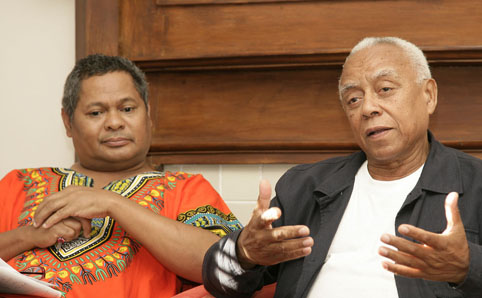 |
|
Dr. Neville Alexander (right) discussed the role of language and culture in creating tolerance in South Africa. On the left is Prof. André Keet, Director of the UFS' International Institute for Studies in Race, Reconcilliation and Social Justice.
Photo: Johan Roux
22 March 2012
|
A multilingual state and culture could lead to more tolerance in South Africa, and schools and universities could play a leading role in the creation of a multilingual culture.
This is according to Dr Neville Alexander, one of South Africa’s foremost linguists and educationalists.
Dr Alexander spoke during a discussion session on language issues in a new South Africa at the University of the Free State’s (UFS) International Institute for Studies in Race, Reconciliation and Social Justice.
He said in a multidisciplinary society, language is central to everything we do.
“Language has the ability to empower people or to disempower them. Yet the present government failed to value the other official South African languages, apart from Afrikaans and English.”
Dr Alexander said it is “convenient and cheap” for the government “to only govern in English”.
Government officials and academics often used the shortage of terminology and glossaries in various African languages as an excuse to use only English as the medium of instruction. This tendency puts young children in the South African school system at a disadvantage since it deprives them of their right to mother tongue education.
According to Dr Alexander, this is similar to the problems that academics experienced centuries ago when only Latin terminology existed for certain disciplines.
“It is the task of educationalists and experts to develop the necessary word lists and terminology to offer more economic value to all our official languages.”
If multilingualism was promoted at school level, a multilingual culture would become more acceptable in future. In this way, we could have an isiZulu of isiXhosa dominant university in South Africa in 30 years time.